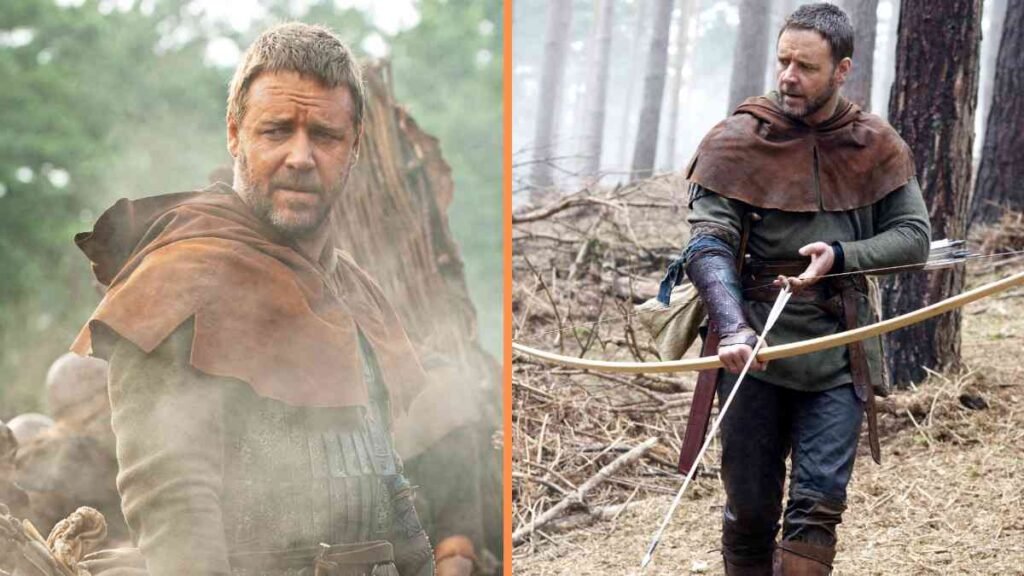The cinematic adaptation of “Robin Hood,” starring Russell Crowe, offers a bold and refreshing take on the legendary English hero. Directed by Ridley Scott, the 2010 film dives deep into the origins of the iconic outlaw, setting the stage for his transformation into a symbol of justice and rebellion. This article delves into the film’s storyline, its compelling characters, and its impact on the audience.
A Fresh Perspective on Robin Hood’s Origin
Unlike traditional portrayals of Robin Hood as a swashbuckling outlaw already entrenched in his fight against tyranny, this movie takes a step back. The story begins with Robin Longstride, a skilled archer in King Richard the Lionheart’s army, returning to England after the king’s death. As he assumes the identity of Sir Robert Loxley, he becomes entangled in the political turmoil gripping the nation.
Ridley Scott’s direction presents a grittier, more realistic portrayal of medieval England. The film explores Robin’s transformation from a soldier to a revolutionary, emphasizing the socio-political landscape of the time. This approach adds depth to a tale that has often been romanticized in folklore.
Russell Crowe’s Powerful Performance
Russell Crowe’s portrayal of Robin Hood brings a gravitas that resonates throughout the film. Known for his intense and commanding performances in films like “Gladiator,” Crowe lends his undeniable charisma to the character. His Robin Hood is not just a hero; he is a flawed, complex individual driven by a strong sense of justice.
Crowe’s rugged demeanor and authenticity make the character relatable, breathing new life into a centuries-old legend. His ability to convey the internal struggles of Robin adds layers to the narrative, making it more than just an action-packed adventure.
Cate Blanchett as Lady Marian
Cate Blanchett delivers a stellar performance as Lady Marian, portraying her as a strong and independent woman. Unlike the traditional damsel-in-distress trope, Marian in this film is a capable and resourceful character who stands as Robin’s equal. Blanchett’s nuanced acting brings a refreshing dynamic to the story, showcasing a partnership built on mutual respect and shared ideals.
Her chemistry with Crowe enhances the emotional core of the film, grounding the larger-than-life tale in genuine human connection.
The Ensemble Cast
The supporting cast of “Robin Hood” is equally remarkable. Oscar Isaac’s portrayal of Prince John is both cunning and flamboyant, adding a layer of intrigue to the narrative. William Hurt’s portrayal of William Marshal exudes wisdom and gravitas, while Mark Addy’s Friar Tuck provides moments of levity. Each character contributes to the film’s richness, creating a world that feels lived-in and authentic.
Realism in Cinematography and Set Design
One of the standout aspects of “Robin Hood” is its commitment to realism. The film’s cinematography, led by John Mathieson, captures the rugged beauty of medieval England. Sweeping landscapes, detailed set designs, and period-accurate costumes immerse the audience in the era.
The battle scenes are intense and meticulously choreographed, showcasing Ridley Scott’s expertise in directing large-scale action sequences. These moments balance raw brutality with cinematic flair, making them both gripping and visually stunning.
A Story Rooted in Historical Context
While “Robin Hood” is a work of fiction, the film’s narrative is rooted in historical context. It explores themes of class disparity, abuse of power, and the struggle for justice. The backdrop of political intrigue and social upheaval adds depth to the story, resonating with modern audiences.
The film’s approach to these themes elevates it from being a mere action movie to a thought-provoking exploration of universal ideals. Robin’s fight against oppression mirrors the timeless battle for fairness and equity, making the story as relevant today as it was in medieval times.
Criticism and Audience Reception
Upon its release, “Robin Hood” garnered mixed reviews from critics. While some praised its ambitious storytelling and strong performances, others criticized its departure from the more traditional elements of the Robin Hood legend. However, audiences appreciated the film’s gritty realism and fresh perspective, finding it an engaging reimagining of a classic tale.
Despite the divided critical response, the film has maintained a loyal fanbase. Its unique approach to the legend has sparked discussions and debates, cementing its place as a noteworthy entry in the Robin Hood canon.
The Legacy of “Robin Hood”
“Robin Hood” (2010) stands out as a bold reinterpretation of a beloved legend. Russell Crowe’s powerful performance, combined with Ridley Scott’s visionary direction, creates a film that is both entertaining and thought-provoking. Its focus on the origins of Robin Hood offers a fresh perspective, setting the stage for future explorations of the character.
This adaptation reminds us that the legend of Robin Hood is more than just tales of heroism and adventure; it is a story of resilience, justice, and the enduring fight against oppression. By grounding the myth in a realistic setting, the film brings new life to a character who has captivated audiences for generations.
Conclusion
Robin Hood Russell Crowe is a cinematic experience that redefines a timeless legend. With its compelling performances, intricate storytelling, and stunning visuals, the film offers a fresh take on the origins of the iconic outlaw. Whether you’re a fan of historical dramas or simply enjoy a good adventure, this movie is a must-watch for its bold reinterpretation of a classic tale.


